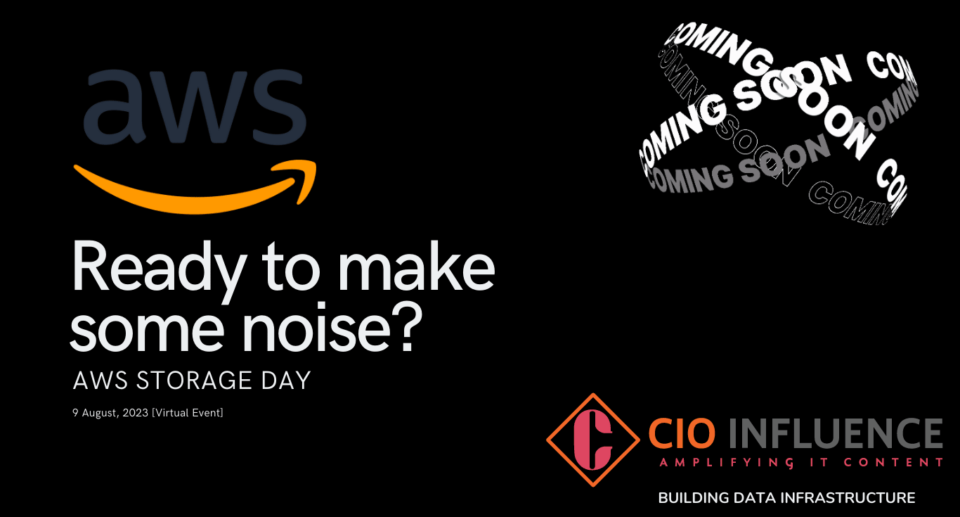We are heading into the new week with a lot of excitement and traction building around the fifth annual AWS Storage Day. This year, AWS Storage Day 2023 would unravel all the CIO-centric conversations related to the evolving nature of Cloud management-as-a-service, cyber security, storage and recovery, and AIOps. From preparing your AI/ML strategy with on-prem and cloud data infrastructure to building a resilient cyber security framework for your current and future requirements, the AWS Storage Day this year will dive into everything you currently need to run your organization more effectively with minimum expenses on Cloud micro-services.
We have identified the top five areas that CIOS, CISOs, and other business leaders and security professionals would benefit from attending the AWS Storage Day 2023.
Supercharge your Machine Learning and Generative AI Workflows in AWS Storage
Every technology leader is now familiar with the word “Generative AI”, and what it can do for search, marketing, sales, and customer service teams. Together with automated Machine Learning and No-code analytics, generative AI has shown tremendous potential in the fields of IT security, data analytics, software development, and Cloud management. Last week, AWS explained how users can fast-track the development of Generative AI tools and democratize its access to all types of customers across all lines of business. At AWS Storage Day 2023, the world’s leading cloud service provider would showcase its ability to deliver high-performance computing and auto-scaling capabilities for different types of machine learning operations, including Foundation Models (FMs) development using Amazon Bedrock. Amazon Bedrock currently supports FMs developed by Amazon, AI21 Labs, Anthropic, Cohere, and Stability AI.
Andy Warfield, Vice President, and a Distinguished Engineer at AWS would deliver the keynote on 9 August, introducing the audience to all the latest AWS Storage innovations that help users get more out of their data with AI/ML capabilities inside AWS Cloud.
Build Powerful Data Lake for AI/ ML and HPC Applications with Amazon S3
Since its launch in March 2006, Amazon Simple Storage Service (Amazon S3) has been an important component in a modern big data stack. It transforms IT and saves millions on storage costs by bringing cutting-edge object storage services to the IT, data ops, and business intelligence teams. AWS leaders would highlight fundamental concepts and advanced use cases related to Amazon S3 and Amazon S3 Glacier at multiple sessions throughout the event.
A dedicated session would explain how AWS users leverage Amazon S3 for high-throughput and low-latency object storage to run sensitive workloads. These include big data analytics, IoT, compliance, live streaming, gaming, AI/ML applications, and hyper-performance computing (HPC) operations running across multiple environments such as data lakes, cloud-native applications, and mobile apps.
Warm up to the Concept of “Cold Data” with S3 Glacier
Depending on how frequently it is accessed, data can be categorized into:
- Hot data: Frequently accessed
- Cold data: Less frequently accessed
Organizations are producing trillions of data points every day, resulting in an uncontrolled growth of “unstructured data”. As CIOs begin to understand the benefits of tapping into cold data, the prominence of cold data storage services is also likely to increase. AWS S3 Glacier is a renowned cold data storage service for managing long-term cold data strategies without tipping the cost when real demands arise from big data analytics, AI/ ML, IoT, and HPC applications.
A session is dedicated to maximizing the value of cold data with resource optimization using AWS S3 Glacier. This session could likely extrapolate on what CIOs should do to prevent their primary data storage facilities from getting overwhelmed by inactive data during key operations. From building a simplified cold data storage to meeting all the compliance and data security requirements, this session during the AWS Storage Day 2023 would provide insights on how to ingest, transform, retrieve, and restore cold data at PB-scale.
Post-Ransomware Data Recovery
Hardening your cloud security stance against ransomware attacks may not deliver the most fruitful results in 2023. It takes a lot more than just data security and predictive threat intelligence.
You need a strong data recovery framework to succeed against ransomware events.
Ransomware attackers are specifically targeting loopholes in cloud infrastructure. In the last few months, ransomware groups have not only increased the volume of coordinated attacks on large-sized organizations but also changed the way they are using technology to identify and exploit vulnerabilities. As organizations fall into the trap of “cyber debt” — a phenomenon where investments in cloud adoption outpace that in cyber security and threat intelligence — the onus lies with the CIOs and CISOs to quickly fortify their existing data recovery strategies. AWS Storage Day has dedicated a session on ransomware recovery strategies and design patterns across the entire AWS portfolio. It could speak about AWS services and their ransomware data recovery practices outlined in the recently published AWS Blueprint document on Ransomware Defence and Risk Management.
Additional sessions are in line featuring the approaches related to the CIA triad, cyber resilience with Commvault, and access control across hybrid cloud storage and edge computing environments.
Listen to Customers, Partners, and AWS Evangelism
AWS Storage Day 2023 is bringing together the community of AWS customers, partners, and internal evangelists who can tell about the finer nuances related to AWS capabilities supporting virtual workloads across a wide range of use cases. Dedicated sessions would focus on the top distinguishable AWS services such as AWS Storage Gateway, AWS Snow Family, AWS Outposts, and others.
What to expect from AWS Storage Day?
The themes chosen for the event are laser-focused on key trending topics and technology workloads spanning numerous high-performance computing and hybrid virtual workloads. The aim of attending the key sessions would be to reduce your TCO, improve resilience and agility, and maximize your storage investments.
If you are looking for specific topics during the event, please let us know. We will relay your thoughts to the AWS events and marketing team.


